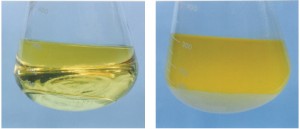Phase Separation in Ethanol

By now most small boat owners will be familiar with the debate raging in boardrooms and congressional halls over the merits of ethanol fuel. We’ve posted before about ethanol lobbyists whose primary goal is to force all boaters to use E15 fuel. And while most of their reasons for doing so are altruistic and pro-environment, the drawbacks of using high-ethanol blends in marine engines are myriad.
It’s not that boat owners are stubborn or set in their ways; to the contrary, they are often willing to embrace the latest technology if it promises to make their hobbies more fuel-efficient and eco-friendly. Unfortunately in the case of ethanol the detriments appear to outweigh the benefits. A process known as phase separation occurs when the ethanol present in blended fuel absorbs water and separates. This leaves multiple layers inside the fuel tank with the majority of ethanol and water – which won’t burn – settling down at the bottom. The marine engine oil remaining on top will have a lower octane rating.
Critics might argue that boat manufacturers need to overhaul their current fuel tank designs, but that problem would do nothing to assuage vintage boat owners or other 2-cycle motor users. Snowmobiles, go karts and chainsaws all feature engines that would be put at great risk if high-ethanol blended fuel entered into the equation. For now it’s up to individuals to make wise choices when selecting their boat oil.

